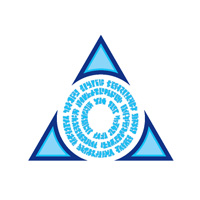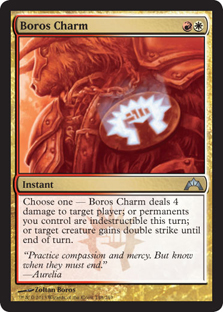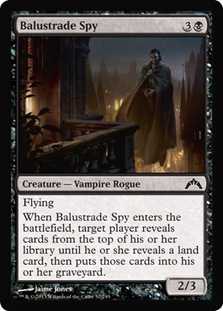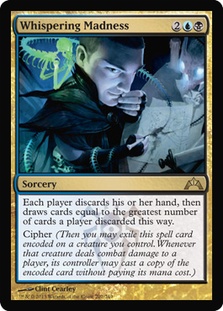Gatecrash Legacy Review
Gatecrash is not going to seriously shake up Legacy.
I wish I could tell you otherwise, but I’m never going to lie to you or hype something that doesn’t deserve it. There are some sweet cards in this set, but there’s nothing on the level of Deathrite Shaman and Abrupt Decay.
There are several unique cards, though. Here’s what they do:
- One counters Abrupt Decay, Engineered Explosives, Perish, and Supreme Verdict, kills planeswalkers, and wins Tarmogoyf wars.
- Another two are a slightly worse Goblin Charbelcher.
- The last one is Windfall.
Every kind of player has something to work with from Gatecrash. Let’s talk about Boros Charm first:
The Good: Charms are about sacrificing raw directed power for the flexibility to remain passably relevant in a greater percentage of Magic’s constantly varying game states. Boros Charm does the latter very well while sacrificing very little power. Let’s talk about the kinds of games in which Boros Charm will be good:
With its first mode:
- If they have a Liliana or a Jace that they didn’t fate seal with, Boros Charm kills their planeswalker.
- This one is pretty straightforward. It synergizes with other cards that want to target their face for points of damage.
With its second mode:
- If your opponent casts and/or activates Abrupt Decay, Maelstrom Pulse, Engineered Explosives, Supreme Verdict, Pernicious Deed, Lightning Bolt, Perish, Wasteland, Armageddon, or Reverent Silence, this mode does something unprecedented for you. If you aren’t in the market for this effect, you should reconsider playing this card. However, you should first consider why you aren’t in the market for this effect.
- You always get to win complicated combat steps where things should normally trade off.
With its third mode:
- You will occasionally do more than your baseline of four points of direct damage with this third mode. Tarmogoyf is real big.
- You get to win heads-up Tarmogoyf wars and can blow out Tarmogoyf + [other creature] vs. Tarmogoyf double blocks.
That all sounds really good, right? The problem is that it doesn’t address any of these situations:
- Jace, the Mind Sculptor’s Unsummon ability.
- Swords to Plowshares, also known as the best removal spell in the format.
- Liliana of the Veil’s Cruel Edict ability.
- Emrakul, the Aeons Torn’s annihilator trigger.
- Their Abrupt Decay on your creature the turn you tap out to play it.
- Lion’s Eye Diamond.
The last one is rather unfortunate since a major part of why Plateau is the worst dual land in Legacy is because Lion’s Eye Diamond routinely beats any deck containing Plateau. The deck that it slots into most obviously—Zoo—doesn’t necessarily want a two-mana card that neither kills a problematic permanent nor stops a combo deck from killing them on turn 3. If I was to come up with a deck that wants Boros Charm for all of its modes, though, it would be one that has enough power to kill on turn 3:
Creatures (12)
Planeswalkers (1)
Lands (23)
Spells (24)

The clear ideal here is Steppe Lynx + Boros Charm for a ton of damage. You have Zektar Shrine Expedition as a Blistering Firecat that can occasionally attack for fourteen on turn 3, and you have the traditional suite of awesome burn spells.
It’s not clear that the incentives are good enough to pull you away from Mono-Red Burn. Burn gives you full protection from Wasteland and color screw, which turns out to be a big deal in a format as fast as Legacy. That’s because people tend to cut down on their mana bases in order to fit in enough action to consistently compete with the most aggressive combo decks, leading to vulnerability to Wasteland strategies. Burn getting to sidestep that whole discussion is more valuable than most people recognize.
We could also try to fit Boros Charm into Zoo, but that deck really doesn’t want more than eight two-drops, meaning we’d be cutting either Thalia, Gaddock Teeg, or Qasali Pridemage from the maindeck to fit in a two-mana card that we are almost never casting on turn 2.
One place where a few Boros Charms might actually be useful is in the sideboard of U/W/R Miracles for the BUG Control matchup. Tundra decks have historically had a problem fighting Liliana of the Veil. Boros Charm answers her without spending multiple cards. It also crosses over to protect Jace from Maelstrom Pulse and Counterbalance / Detention Sphere / Oblivion Ring / Angel token from Abrupt Decay. If there’s a place for Boros Charm, it might well be in a deck with no Plateaus at all.
The next two cards on the list are Balustrade Spy and Undercity Informer.
Adam Prosak unveiled a tight little combo deck featuring this duo of self-milling four-drops earlier this week. You can find his article here. I don’t want to pooh-pooh his brew, but I do want to have an honest discussion about how it stacks up against Goblin Charbelcher.
Both decks can kill on turn 1. It’s fairly easy to break down the roles that cards play in each deck. The lists of Belcher and Oops!, for reference:
Creatures (28)
Spells (32)

Spells (47)
- 4 Land Grant
- 4 Desperate Ritual
- 4 Burning Wish
- 4 Goblin Charbelcher
- 4 Seething Song
- 4 Lotus Petal
- 4 Lion's Eye Diamond
- 3 Chrome Mox
- 4 Rite of Flame
- 3 Empty the Warrens
- 4 Manamorphose
- 1 Pyretic Ritual
- 4 Gitaxian Probe
Sideboard

Both have a similar number of "kill conditions"—cards that either end the game immediately or effectively win the game when cast. Belcher has eleven: four Charbelcher, four Burning Wish for Empty the Warrens, and three Empty the Warrens. Oops! has eight: four Balustrade Spy and four Undercity Informer. Without one of these cards in an opening hand, you have to go back for a new hand.
Both decks have Manamorphose and Gitaxian Probe, although Oops! has Street Wraith as well. This means that Oops! is going to have to keep a slightly broader range of speculative hands based on expecting to draw a certain type of card in its first three to five draws since you aren’t supposed to mulligan four cyclers and three mana sources—you just have to hope for the best.
Where the decks differ, sadly, is in the count of initial mana sources. While both decks are light on mana counts, Belcher has a whopping twenty cards that are free to cast or activate and produce one mana. Oops! only has eight cards in its deck that initially produce black mana, and four of those are Chrome Mox, where you need to imprint one of 21 cards in the deck (one of your seven remaining kill cards, four Street Wraith, eight Rituals, and two Cabal Therapy). If you’re not good at drawing Lotus Petal, you’re probably going to have a bad time with this deck.
Believe me, I would love nothing more than to see another flavor of turn 1 combo decks get its fifteen minutes of fame in Legacy. I just can’t endorse it over a deck that is two and a half times more likely to get to cast its mana sources. If there was a Zombie Spirit Guide, things would be so much different…
Of course, if Zombie Spirit Guide were a real card, Whispering Madness would be even more absurd. As it stands, I expect Whispering Madness to find its way into a hyperaggressive Storm shell that wants a lot of draw 7s.
Once upon a time, people evoked Slithermuse to draw cards or cast Diminishing Returns to reset their hand. At first blush, Whispering Madness looks like a worse version of both of those cards. But Slithermuse doesn’t let you ditch the cards in your hand, and Diminishing Returns leaves you without a graveyard and is thus a drastically weakened Cabal Ritual. With Whispering Madness, you can play Windfall and almost guarantee that any Cabal Rituals you draw will produce five mana. Cabal Ritual has historically existed in slower combo decks with more cantrips. This is because those decks need more cards to fight through well-prepared walls of counterspells, thus requiring that any dedicated mana-producing cards be incredibly potent.
You can’t craft a four-land mana base, spend your first two cards on Duress and Cabal Therapy, and then follow it up with Lotus Petal and Rite of Flame. You’re not going to be able to cast anything worthwhile. If you follow those spells up with Cabal Rituals, however, you can frequently chain Infernal Tutors—that is, cast one to find another—to reach ten storm and cast Tendrils of Agony.
The counterargument for Whispering Madness is that you play a card like Diminishing Returns to be able to recover from discard-heavy starts from an opponent that leaves both players short on resources. Whispering Madness can’t really replace that effect because discard decks have a habit of emptying their hand to empty yours. From that position, Windfall is quite weak, making Diminishing Returns a more valuable card in the sorts of situations where you need help from a unique card slot.
Why You Should Play Storm This Weekend
Let’s table the Gatecrash discussion for now. The format of the most recent MOCS season was Legacy. The community got to watch streams of Legacy Daily Events every night for a month, which was a joy for me. What was even better is what came after the season ended.
They reprinted Force of Will online.
I’m a pragmatist. I get that Legacy is going to eventually be an online-only format. Wizards can monetize it most efficiently from that platform, players don’t have to deal with all the tournament delays that once-a-turn shuffling creates, and card availability is never going to be an issue in the digital realm.
That’s why I was thrilled—really, truly thrilled—to see Wizards of the Coast create another batch of Force of Wills for players who love Magic for the joy of never ever casting Brainstorm. And while I won’t be playing in the upcoming MOCS season finals, I do know what I would play if I were qualified.
I would play exactly what I played at Grand Prix Denver:
My losses in the Grand Prix were to losing the die roll to Belcher, getting Silenced in the Storm mirror, getting Trinisphered on turn 1 by Metalworker, and getting turn 1’d in the mirror. I easily beat every fair deck that I played against, including killing an opponent through Chalice of the Void on one and beating a hand of two Force of Will, two Stifle, a Spell Pierce, and a Flusterstorm with Insectile Aberration in play.
This list is a close derivative of Timo Schunemann’s Grand Prix Ghent-winning deck. I cut a Badlands for a Bayou in the maindeck and changed his sideboard to accommodate for the disappearance of Maverick and Reanimator.
My process toward this list began before the Los Angeles Invitational, where I ended up playing Five-Color Storm. I wasn’t planning on playing Storm when I flew to California, but I switched to it after testing Esper Stoneblade and being thoroughly disgusted by how mediocre it felt against everything. As a friend pointed out to me several times throughout my testing process, "Jace and Jitte look like the only good cards in your deck. Literally everything else is just garbage. Why are you playing this?" I didn’t have an answer, so I learned to love Lion’s Eye Diamond.
The problem with Five-Color Storm is that it’s incredibly soft to RUG Delver. The combination of cheap interaction and mana base disruption is too much to handle. Five-Color Storm isn’t built to wait out other decks, and it’s nearly impossible to jam a turn 2 kill against a deck filled with stack interaction.
I turned to Adam Prosak Storm list next, but I wasn’t thrilled with how action-light it felt. I wanted more than just Infernal Tutors, but I didn’t want a five-color mana base. I knew I wanted to cut his Gemstone Mines. How was I supposed to reconcile my desire for basic lands with my desire for more Tutors?
I found my answer after doing more research into the evolution of Storm. Timo Schunemann’s win in Ghent got entirely too little press in this hemisphere. You need look no further for proof of that than the Open Series. In the weeks after Atlanta, people played carbon copies of Gaudenis Vidugiris RUG Delver list and Michael Majors Esper list. In the weeks after Ghent, people still wouldn’t pick up Storm. I have no idea why.
The reason I wanted to play Timo’s list over Adam’s list is that Timo’s has more action and more disruption—nine action cards to Adam’s five and seven discard spells to Adam’s six. The key difference? Preordain versus Burning Wish.
Preordain is good if the range of possible interaction is very narrow. If you need to play the same game of Magic over and over, Preordain is where you want to be. Unfortunately, you could get Hymned one match, Counterbalanced the next, and Show and Telled the match after that. The deck needs more play than Preordain.
I also wanted a smaller sideboard. I was very wary of oversideboarding because combo decks can’t ever cut most of their cards. There are a few disruption slots that can change, but adding eleven cards is almost always worse than adding none. After all, what if you draw four sideboard cards? You can’t win!
This led me to look for a good Burning Wish list, and once I goldfished Timo’s list a few times, I knew I had what I wanted. Timo had Badlands as a black source that can incidentally cast Burning Wish or Past in Flames, but I knew it could be replaced by Bayou at a minimal loss of utility. The important thing is to be able to cast a cantrip into a discard spell into a Ritual with Underground Sea, Volcanic Island, and a third land, which Bayou enables just as well as Badlands.
Another part of why I like Timo’s list so much is that it has four Cabal Therapy. If you’ve done your research, Cabal Therapy is the most rewarding card to cast in the entire format—far beyond Brainstorm. In Storm, you don’t care about flashing back Therapy. You just want to get all of their copies of a key piece of interaction. After all, what happens when you Duress them and see two Force of Will and a Stifle? Are you just supposed to wait forever to draw two more Duresses? Let’s not even get into what happens with turn 1 Gitaxian Probe. It’s just not fair to cast a Thoughtseize with upside on turn 1 with this deck.
The sideboard is where most of my research paid off. Timo’s Ghent list had Grafdigger’s Cage and Dread of Night to combat Reanimate and Thalia. I knew that my Denver enemies were Hymn to Tourach and Counterbalance, though, so a new sideboard was in order. After playing a few games, I had my first major insight:
Abrupt Decay is not actually that good against U/W Miracles. You can Duress or Therapy away their Counterbalance. They often don’t play four. You board into ten discard spells, so you’re casting one more or less every turn. Abrupt Decay doesn’t have impact if they don’t have Counterbalance, whereas Duress still takes their Spell Snare and lets you kill them in the same turn. As a result, I knew that I didn’t want four Decay in my sideboard and likely didn’t even want three Decay against Miracles. So much for conventional wisdom.
The next insight came while studying Adam’s sideboard. If everyone is expecting Abrupt Decay and Carpet of Flowers, there’s no compelling reason to keep in any spot removal. Xantid Swarm had not yet picked up in popularity, so it would have made sense for people to cut their removal after sideboarding. This made boarding in a creature a very attractive prospect. The question, of course, was which one.
Given how many discard spells I was expecting, I wanted Dark Confidant. The ability to cast him on turn 1 and play a disruptive game from behind a two-power attacker plus Archivist was too appealing to turn down. Besides, if anyone tapped out to deal with Bob, I could just Therapy them for Force of Will and go to town. Despite all of the upsides, I knew I never wanted to draw three Bobs over the course of the game, so I decided on sideboarding three total.
The Grim Tutor is entirely necessary. You can’t sideboard Ad Nauseam, so being able to Wish for a way to get Ad Nauseam can be relevant. You want Grim Tutor as a Tutor for Past in Flames since playing one main and one sideboard is too inefficient. You can’t cut the maindeck copy, though, because Infernal Tutor will find it at least as often as Tutor finds Ad Nauseam. Against Delver decks, Past in Flames is almost always your kill.
Beyond Tutoring for maindeck cards, Grim Tutor is also a key cog in chaining Tutors. For instance, if you have six storm, eleven mana, and a Burning Wish in hand, you want to be able to Wish for a guaranteed win. Your line (with access to a Grim Tutor) is simply Wish for Grim (storm seven), Grim for Infernal (storm eight), Infernal for Tendrils (storm nine), Tendrils them (for 20). Without Grim, you might have to get Empty the Warrens or something equally risky. Since the deck can produce a huge amount of black mana with multiple Cabal Rituals, Grim Tutor excels as a sideboard card.
Pyroclasm is a better Infest because no one plays Mother of Runes anymore and you care about the one mana difference when you have to kill a Thalia. If someone goes Mother of Runes into a hate bear, good for them. Make them have both again next game.
Duress and the Inquisitions come in against blue decks to replace the Mox and two Gitaxian Probes. Since you’re looking at their hand every turn anyway, there’s no reason to pay two life to not take a card. We won’t need to build our storm count where we’re going.
The Empty the Warrens and Tendrils of Agony are stock card slots. I never Wished for Empty and could see cutting it, but it’s a good safety valve against Leyline of Sanctity or something similar.
The last two slots are both mine. Reverent Silence is the Abrupt Decay that Gotham needs and deserves because it hits the previously untouchable Leyline of Sanctity as well as any additional copies of Counterbalance that may be sitting around. Rule of Law? Blow it up! Wild Growth? Screw you, dude!
Time Spiral raised the most eyebrows, but it makes perfect sense once you realize what Diminishing Returns actually costs. The typical scenario for wanting a draw 7 is against discard-heavy decks that have shredded our hand but can’t kill us for a few turns. We want to Wish for a card that can draw us a hand filled with mana and one or two action cards. But how much mana do we have?
In games against Miracles and BUG, I ended up finding all six permanent mana sources before casting Burning Wish. Having access to a lot of mana after drawing seven cards is a huge advantage, and that access is often the difference between winning and passing the turn to a deck with a bunch of live discard in its hand.
Although the deck is complicated to play and requires an intuitive understanding of the many lines of play available at any given time, it is by far the most intellectually rewarding deck I have played in my life. Whether you try it out for the MOCS or SCG Legacy Open: Atlanta this weekend, I highly recommend playing a few matches with Storm.
Wherever you are this weekend, good luck!
 |
I am Azorius. I work to change the world into the world I believe it ought be. I believe that government can protect people from harmful elements in human nature and nongovernment organizations. Logic should temper passion, and so change should be slow precisely because we must understand that which is our desired end. |





